29th May 2008 : A Wild Variety Show
 Thursday, May 29, 2008 at 04:10PM
Thursday, May 29, 2008 at 04:10PM There’s been a lot of to-ing and fro-ing of wild things over the past few days so I’m going to have to tell you about it all in fits and starts, as I find the time…one thing which is extraordinary is how much the big beach down at Hippo Bend has changed with the high flood waters while we were away. The high ledge has been cut away completely, and now the beach is just huge and flat, with a sudden very tall step up to the riverine vegetation right at the outer edge. The Vervet Monkeys have babies in tow at the moment, as do the baboons. They’re very cheeky and cute, riding “under-slung” beneath their mother’s belly.
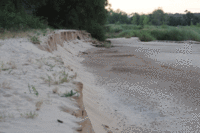
The sand ledge has been cut right back
Click any image to enlarge
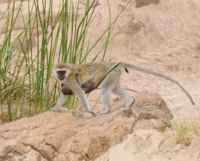
Vervet Monkey mother and baby
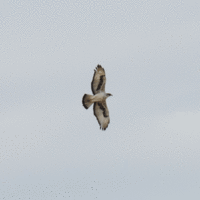
African Hawk Eagle in flight
It’s strange not to see our swallows or sandpipers around – they’re up in Europe by now. Nonetheless, it’s certainly been a bird watcher’s paradise recently, with a great variety of eagles soaring on the hot winds, all sorts of other fine-feathered visitors (more about them in upcoming posts) and quite a few comical avian sightings too.
Tell me: what is it about storks and standing on one-leg? The other evening we saw this Marabou Stork performing a “one legged ballet” in the treetops – it transpired (I think) that it was merely trying to balance on a rather precarious perch on a decidedly windy day. It seems that standing on one leg is something the Yellow-billed Storks like to do too…and speaking of Storks, a couple of Woolly-necked Storks are back at Hippo Bend again. They’ve been there for several days in a row now. The light was bad when I photographed them, but nonetheless they deserve to be featured here too, I feel!
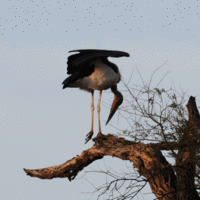
One legged Marabou ballet
Click any image to enlarge
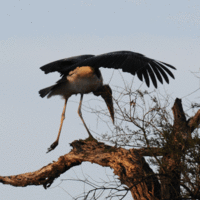
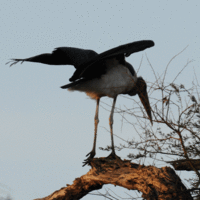
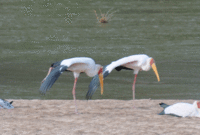
Yellow-billed storks on one leg each
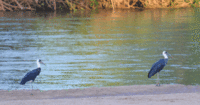
Woolly-necked Storks
Speaking of all these different storks, brings to mind something which always amazes me, and that is the staggering diversity of nature. Even “small shifts sideways” create amazing varieties of creatures and plants. Take, for example, the three different types of Hornbills we’ve seen around the house in the last couple of days – similar to each other, yet each so different…
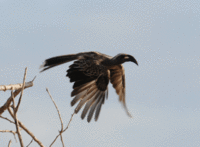
Grey Hornbill
Click on any image to enlarge
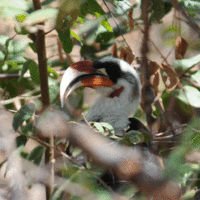
Von der Decken Hornbill (male)
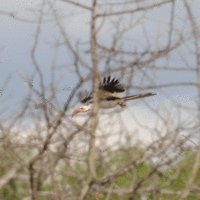
Red-billed Hornbill in flight
Mongooses are another case in point. A few days back we saw a band of Dwarf Mongooses carrying their tiny babies across the road, en route to a termite mound where they would have been spending the night. Dwarf Mongooses are fascinating little creatures. They’re like bees in the sense that one animal cannot survive alone without a certain number of others. In order for these tiny mongooses to survive, each band needs to comprise a minimum of four-five members, each with strictly designated roles: the Alpha Female (leader of the pack and the only female to bear young), the Alpha Males, at least one Look-out, and at least one Nanny (if there are two babies in the group, then the Alpha Female will carry one, the Nanny will carry the other. If there are more than two babies, another Nanny is needed.) The mongooses move sleeping sites every day within their territories, carrying their babies in their mouths, in order to lessen the threat from predators, chief among which is the Grey Spitting Cobra.
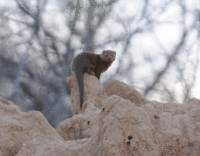
Dwarf Mongoose look-out on top of the termite mound where the band's babies have been hidden
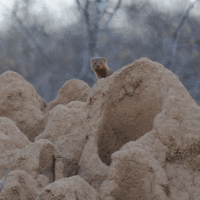
Dwarf Mongoose watching us closely
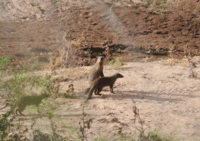
Banded Mongooses, slightly obscured by vegetation
Another social mongoose is the Banded Mongoose, which is bigger than the Dwarf Mongoose and more heavily set than the Black-tipped. As luck would have it, a band just passed by the house this morning. My view of them was not very clear, there were bits of vegetation in the way, but nonetheless I hope you can see their distinctive striped coats which give them their name. This band had big babies with them, already capable of foraging for themselves.
The Verraux Eagle Owl and the Pearl Spotted Owlette are also examples of large and small...
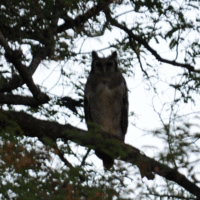
A giant among owls: the Verraux
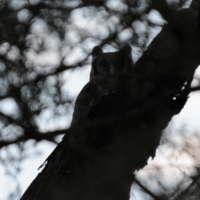
...from another angle, after the owl had hopped to another branch
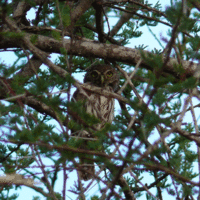
At the other end of the scale, a diminutive Pearl-spotted Owlette
The other evening we saw a Verraux Eagle Owl, a giant among birds, in the big riverine trees by Hippo Bend. These owls are HUGE, and they are all the more extraordinary for their pink eyelids, which you see each time they blink. The light was already low when we spotted the owl, but I hope you can make him out in the photos. As we were walking back to the house, we turned and looked back over our shoulder, and there he was again, this time right underneath the Marabou with a penchant for one-legged ballet…
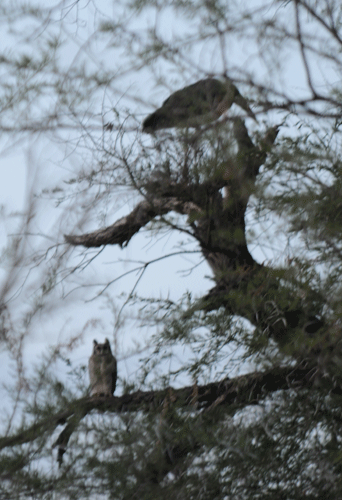
WANT TO SEE MORE SIMILAR PHOTOS OF OWLS, MONGOOSES, VERVETS, LANDSCAPES?
Animals
Birds
Kulafumbi Landscapes





Reader Comments (10)
Thanks so much for all this fascinating information. These creatures are truly amazing.
My uncle, who lives in Zambia, had a vervet monkey for about fourteen years from when it was a tiny baby. When I visited, it saw me as a rival for my uncle's affections and started our relationship by biting me hard on the upper arm. After that I carried a big stick and a mutual respect grew between us to the extent that she would share my evening rum and coke with me. However, get too close to my uncle and the teeth would be bared. Unfortunately, she got sick and when they took her to the vet, he gave her something which killed her. My uncle is still devastated a year later.
Hi Suzanne - that's a sad tale about the Vervet Monkey. You're right though, these animals are so amazing. Over the years, we've looked after/raised various wild animals which we've rescued after illness or injury and then re-introduced back into the wild. Each and every one of them had such a distinctive character. Even birds had incredible individual characters and mood swings and likes and dislikes when it came to different people...amazing. They are so much cleverer and so much more individual than many people give them credit for, IMHO.
Your swallows are back in our garden ! One day you think, what's that noise and look, the swallows are back. They are breeding under our rooftop and are very very busy feeding the little ones. The squirrell is still looking for all the nuts he hid last year. Very funny sight, running up and down the garden, digging eveywhere. We can see where he left some because trees are growing there now, in very strange places !
Hello there!
This is why I love blogshopping--I get to learn new things and see interesting pictures. The place you live in looks like a paradise :) I live in the city and have always wanted to live in the peaceful and calm countryside with trees and lots of animals around.
I think there is something about having Danish blood that draws people to birds.. as i read you post, all i could think of is - my danish boyfriend woudl love the bird pictures. He is an avid twitcher, a passion i have to say i do not share - not in those depths.
Great photos!!
Hi,
I just voted for your blog for Bloggers Choice Awards.
Could you please return the favor at:
http://www.bloggerschoiceawards.com/blogs/show/21620
Thanks,
SpEdLaw2
Hey Tanya,
I've upgraded our website and put some more pictures on it. You can have a look on it : www.bao-safari.nl
Audrey
I have a new found love for mongooses... we met a couple of sweethearts in the Mara. Look out for photos and post on the blog soon.
Apologies to everyone for my tardiness in replying....thanks so much for stopping by and leaving your comments...Audrey, I'm so glad "our" swallows have found somewhere nice to spend the summer ;-) ...great to hear you've added more photos to your blog - I'm going to go and take a look now! Also looking forward to seeing the mongooses on yours, Imogen...and thanks for the vote SpEdLaw2 - I'll be sure to hop over and have a look at your blog too...I'm so behind...just haven't had time to read anyone's blogs recently - in fact, as you've probably noticed, I don't even have time to update my own regularly enough!
roadrunner email , roadrunner webmail